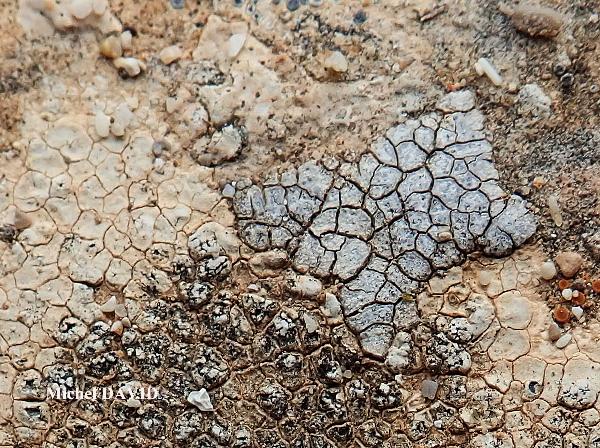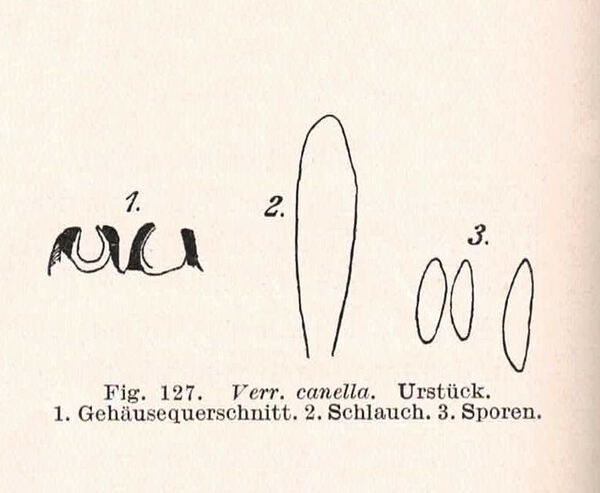Placopyrenium canellum (Nyl.) Gueidan & Cl. Roux
in Navarro-Rosinés & al., Bull. Soc. Linn. Prov., 58: 174, 2007. Basionym: Verrucaria canella Nyl. - Flora, 66: 102, 1883.
Synonyms: Verrucaria aspiciliae Zehetl. non (J. Lahm) Stizenb. nec Vain.; Verrucaria aspiciliicola R. Sant.; Verrucaria glaucina subsp. canella (Nyl.) A.L. Sm.
Description: Thallus crustose, episubstratic, well developed, areolate, 0.25–0.6 mm thick, the areoles angular, flat, constricted at base and separated by deep cracks, 0.2-1 mm wide, pale grey, usually pruinose, the margins and the sides dark brown to black. Cortex poorly defined, paraplectenchymatous, the cell walls with a brown pigment, overlain by an up to 10 μm thick epinecral layer; medulla colourless to patchily dark pigmented. Perithecia black, 1-5 per areole, immersed, the apex flattened to slightly convex, 0.1-0.2 mm across. Involucrellum absent or poorly developed around the ostiole (appearing as a thickening of the exciple); exciple colourless to brown in lower part, dark brown in upper part, the pigmented parts K+ slightly darker or greenish brown; hamathecium of periphyses and periphysoids, interascal filaments absent; hymenial gel hemiamyloid, I+ red (I+ blue at very low concentrations of I), K/I+ blue. Asci 8-spored, clavate, I-, fissitunicate, the wall thickened above with an indistinct ocular chamber, Verrucaria-type. Ascospores 1-celled, hyaline, narrowly oblong or ellipsoid, (18.5-)21-27(-30.5) x (6.5-)7.5-9(-10.5) μm, surrounded by a up to 1.2 μm thick gelatinous perispore. Photobiont chlorococcoid. Spot tests: cortex and medulla K-, C-, KC-, P-, UV-. Chemistry: without lichen substances.
Growth form: Crustose
Substrata: rocks
Photobiont: green algae other than Trentepohlia
Reproductive strategy: mainly sexual
paras Circinaria calcarea s.lat.
Commonnes-rarity: (info)
Alpine belt: absent
Subalpine belt: rather rare
Montane belt: rather common
Dry submediterranean belt: very common
Humid submediterranean belt: very common
Padanian area: extremely rare
pH of the substrata:
1 2 3 4 5
Solar irradiation:
1 2 3 4 5
Aridity:
1 2 3 4 5
Eutrophication:
1 2 3 4 5
Poleotolerance:
0 1 2 3
Altitudinal distribution:
1 2 3 4 5 6
Rarity
absent
extremely rare
very rare
rare
rather rare
rather common
common
very common
extremely common
Loading data...
Occurrence data
Predictive map
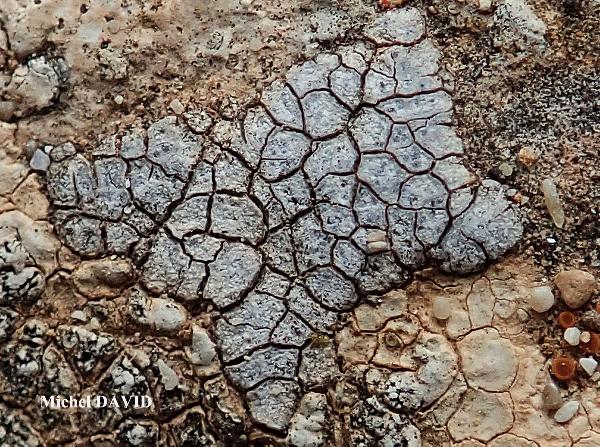
Michel David - Source: http://www.lichensmaritimes.org/index.php?task=fiche&lichen=1344&lang=en
Spain, Baleares, Ibiza, Cala Gracioneta San Antonio
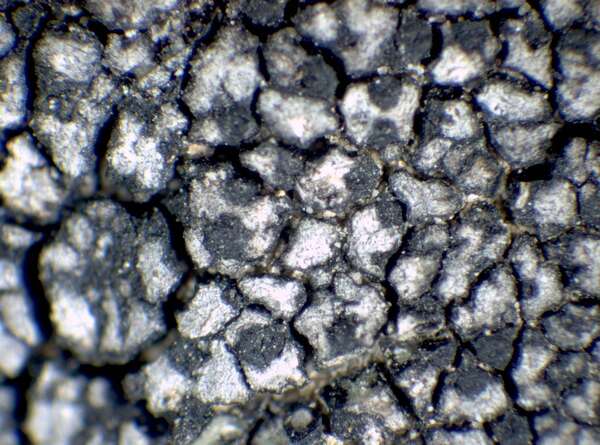
P.L. Nimis; Owner: Department of Life Sciences, University of Trieste
Herbarium: TSB (11395)
2001/12/03
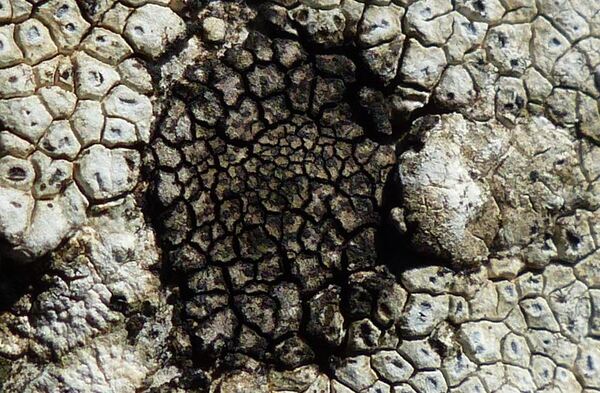
Andrea Moro; Owner: Department of Life Sciences, University of Trieste
italy, Friuli Venezia Giulia, Trieste, Trieste Karst near Borgo Grotta Gigante
16/02/2017
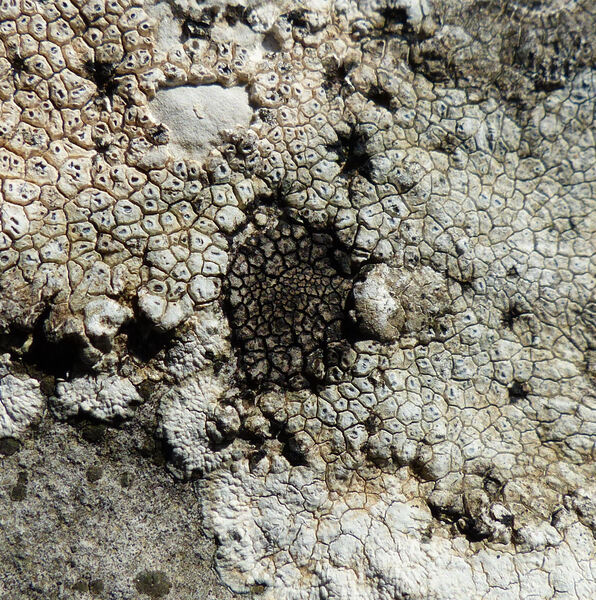
Andrea Moro; Owner: Department of Life Sciences, University of Trieste
italy, Friuli Venezia Giulia, Trieste, Trieste Karst near Borgo Grotta Gigante
16/02/2017
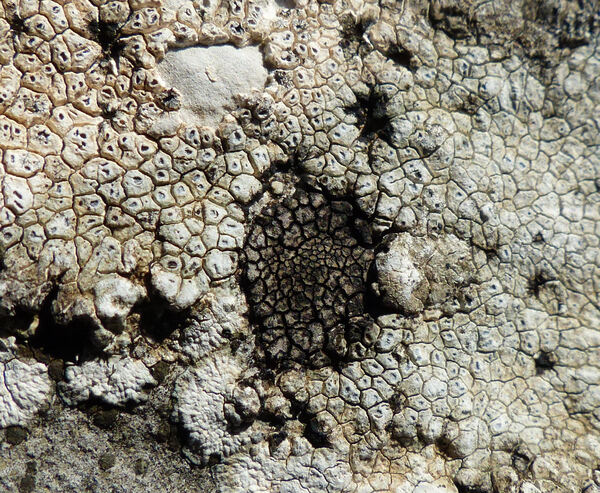
Andrea Moro; Owner: Department of Life Sciences, University of Trieste
italy, Friuli Venezia Giulia, Trieste, Trieste Karst near Borgo Grotta Gigante
16/02/2017
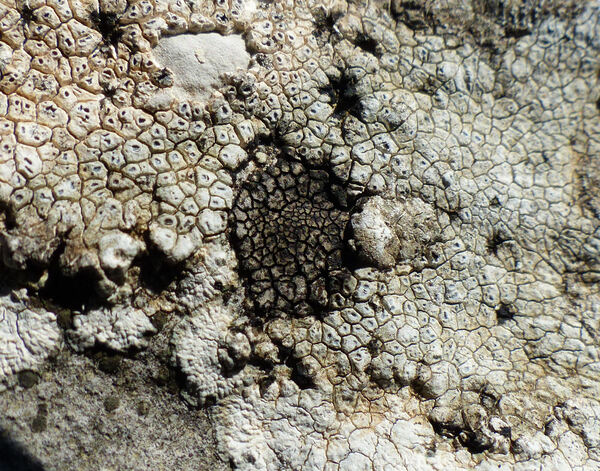
Andrea Moro; Owner: Department of Life Sciences, University of Trieste
italy, Friuli Venezia Giulia, Trieste, Trieste Karst near Borgo Grotta Gigante
16/02/2017
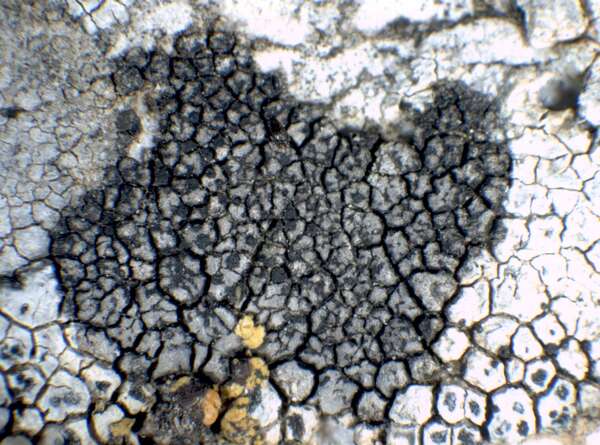
P.L. Nimis; Owner: Department of Life Sciences, University of Trieste
Herbarium: TSB (11395)
2001/12/03
on the host, Aspicilia calcarea
Growth form: Crustose
Substrata: rocks
Photobiont: green algae other than Trentepohlia
Reproductive strategy: mainly sexual
paras Circinaria calcarea s.lat.
Commonnes-rarity: (info)
Alpine belt: absent
Subalpine belt: rather rare
Montane belt: rather common
Dry submediterranean belt: very common
Humid submediterranean belt: very common
Padanian area: extremely rare
pH of the substrata:
| 1 | 2 | 3 | 4 | 5 |
Solar irradiation:
| 1 | 2 | 3 | 4 | 5 |
Aridity:
| 1 | 2 | 3 | 4 | 5 |
Eutrophication:
| 1 | 2 | 3 | 4 | 5 |
Poleotolerance:
| 0 | 1 | 2 | 3 |
Altitudinal distribution:
| 1 | 2 | 3 | 4 | 5 | 6 |
Rarity
absent
extremely rare
very rare
rare
rather rare
rather common
common
very common
extremely common
Loading data...
Occurrence data
Predictive map

Michel David - Source: http://www.lichensmaritimes.org/index.php?task=fiche&lichen=1344&lang=en
Spain, Baleares, Ibiza, Cala Gracioneta San Antonio

P.L. Nimis; Owner: Department of Life Sciences, University of Trieste
Herbarium: TSB (11395)
2001/12/03

Andrea Moro; Owner: Department of Life Sciences, University of Trieste
italy, Friuli Venezia Giulia, Trieste, Trieste Karst near Borgo Grotta Gigante
16/02/2017

Andrea Moro; Owner: Department of Life Sciences, University of Trieste
italy, Friuli Venezia Giulia, Trieste, Trieste Karst near Borgo Grotta Gigante
16/02/2017

Andrea Moro; Owner: Department of Life Sciences, University of Trieste
italy, Friuli Venezia Giulia, Trieste, Trieste Karst near Borgo Grotta Gigante
16/02/2017

Andrea Moro; Owner: Department of Life Sciences, University of Trieste
italy, Friuli Venezia Giulia, Trieste, Trieste Karst near Borgo Grotta Gigante
16/02/2017



